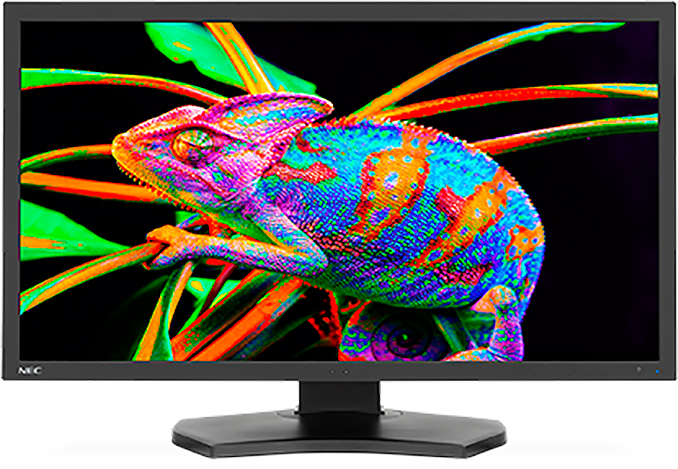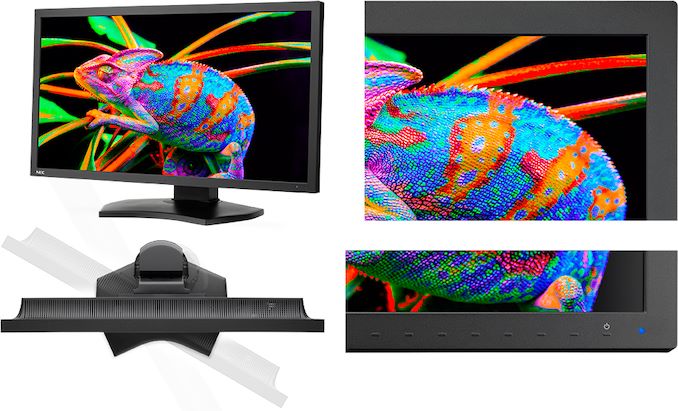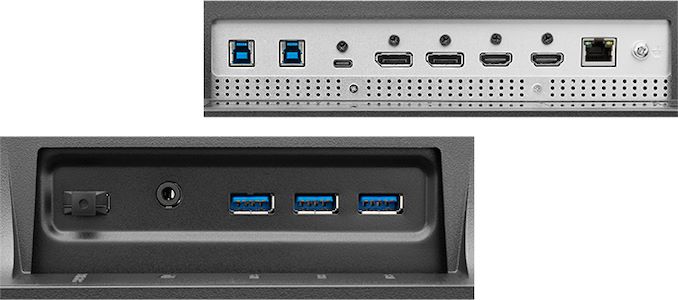NEC's MultiSync PA311D, a 10-bit IPS 4K Professional Monitor
by Anton Shilov on November 20, 2019 10:00 AM EST
NEC this week introduced a new professional display for color critical applications. The NEC MultiSync PA311D LCD features a 4K resolution, covers 100% of the AdobeRGB color space and is aimed at people working with computer graphics, video, and photography. The monitor supports sophisticated connectivity, including a USB-C input that supports 65 W power delivery.
The NEC MultiSync PA311D LCD display is based on a 31.1-inch 10-bit IPS panel with a true 4K resolution of 4096×2160. Combined with its wide gamut W-LED backlighting, that can reproduce 1.07 billion colors across 99.9% of the sRGB, 97.4% of the NTSC, and 100% of the AdobeRGB color gamuts. The monitor features a peak luminance of 350 nits, a 1400:1 contrast ratio, an 8 ms typical response time, and unusual for a pro grade monitor, a top refresh rate of 75Hz.
Being aimed at professionals, the monitor uses NEC’s custom color processor and comes with a 14-bit 3D LUT (look-up table) for color gradations. NEC has also implemented an always-on backlight sensor here, in order to offer steady colors and brightness levels. And of course, monitor calibration is supported through the company’s SpectraView II calibration software (with a color sensor sold separately or as a part of an appropriate bundle).
One unexpected capability of the monitor is that it is touch capable, and it comes with an appropriate stand that can adjust height, tilt, swivel, or change the LCD’s orientation.
The pro monitor also offers a few different input options. The monitor has two DisplayPorts, two HDMI ports, and a USB Type-C connector, the latter of which is still relatively new to professional LCDs. The USB-C port can deliver up to 65 W of power to its host PC, which is enough for most 13 and 15-inch class laptops. In addition, the display has a GbE jack, a 3.5-mm jack for headphones, and a triple-port USB 3.0 hub with two USB Type-B upstream ports.
| Specifications of the NEC MultiSync PA311D Display | |
| PA311D | |
| Panel | 31.1" IPS |
| Native Resolution | 4096 × 2160 |
| Maximum Refresh Rate | 75 Hz |
| Response Time | 8 ms |
| Brightness | 350 cd/m² (typical) |
| Contrast | 1400:1 |
| Viewing Angles | 178°/178° horizontal/vertical |
| 3D LUT | 14-bit LUT |
| Dynamic Refresh Rate | none |
| Pixel Pitch | 0.170 mm² |
| Pixel Density | 149 ppi |
| Display Colors | 1.07 billion |
| Color Gamut Support | DCI-P3: ?% Adobe RGB: 100% sRGB: 99.9% NTSC: 97.4% |
| Aspect Ratio | 1.9:1 |
| Stand | Can adjust tilt, swivel, height, and change orientation |
| Inputs | 2 × DisplayPort 2 × HDMI 2.0a/2.0b 1 × USB-C with 65 W PD |
| USB Hub | 3-port USB 3.0 hub |
| GbE | 1 × GbE |
| Launch Date | November 2019 |
NEC’s PA311D professional monitor will be available later this month directly from the company for $2,999 or $3,249 for SpectraView bundle. Besides calibration bundle, users can also get a special lighting hood for the monitor to ensure consistent color reproduction at all times and in all environments. The display is backed by a four-year warranty.
Related Reading:
- NEC Launches V554Q: A 55-Inch 4K Monitor for Professional & Signage Applications
- NEC Goes for a Curved Display, Launches 3440×1440 MultiSync EX341R Monitors
- NEC Launches Narrow Bezel MultiSync EA271U Display: 4K & USB-C Charging
- EIZO Announces ColorEdge Prominence CG3145: 4096x2160, 98% P3 and HDR10
Source: NEC












52 Comments
View All Comments
Canam Aldrin - Saturday, November 23, 2019 - link
With 3D LUTs, you can calibrate to whatever colorspace you need. So there is your P3 support. People who don't know how to do this shouldn't be working in P3 anyway.Pro-competition - Wednesday, November 20, 2019 - link
75 Hz. Is no one commending NEC for having a higher than usual refresh rate? Sure, 120hz would be far more welcomed, but even 75hz is noticeably smoother than 60hz.melgross - Thursday, November 21, 2019 - link
For what professional purpose? If it’s used for graphics, then it’s not useful. For video, it’s not a standard refresh rate.For gaming, it might be better, but this is supposed to be a pro graphics/video monitor, not a gaming monitor.
Canam Aldrin - Saturday, November 23, 2019 - link
If they can do fractional framerates below 72Hz, it is useful, because then you can do 71.94Hz which is 3x 23.98, giving you nice smooth playback of "24p" video. 60Hz is messy for this since it's having to drop every other frame (well, that's over-simplifying how it works but you get the idea).hennes - Thursday, November 21, 2019 - link
"including a USB-C input that supports 65 W power delivery". I read this as the power to the monitor is supplied via USB-C (input to the monitor). Not that it could supply either devices with up to 65W (power output).USB-C port and USB-C input are almost the same. But since this is not an input "port" might be clearer.
yetanotherhuman - Thursday, November 21, 2019 - link
Huh, that's a novelty, an actual 4K monitor as opposed to Ultra HD.DBsuper - Thursday, November 21, 2019 - link
3000 Dollars only at 75hz refresh rate? Hahahahhaahaha are you joking being really stupid NEC? 31 INCH TOO!! HAHAHAHAHAAHHAHAHAHAHA CAN'T STOP LAUGHING.imaheadcase - Thursday, November 21, 2019 - link
Are you stupid or something?Canam Aldrin - Saturday, November 23, 2019 - link
Then you're laughing in the mirror because you are completely ignorant. This is probably the least important spec for the target market. But of course, just assume that NEC, what with all their engineers and years of success in this market, are the idiots who don't know how to spec or price their product. Maybe consider understanding things before you speak on them?we_are_theBorg - Sunday, December 8, 2019 - link
I see a lot of videographers commenting on here but no photographers. As far as I can tell this series has always been produced for photography, pre-press and medical imaging markets, not video, hence not marketing a P3 color gamut or being HDR. I am a protog and do fine art printing for other clients too. I have exclusively used NEC PA series monitors for many years. For me the only specs that really matter are the 100% Adobe RGB gamut and the 14 bit lookup table. It's nice to get bumps in resolution and contrast on this series, but nothing else really matters. When doing print proofing the standard is between 80 and 120 nits brightness, so 350 is super overkill. Same is true for the medical DICOM standards for the medical market that NEC sells lots of these to. Another big advantage that NEC has over many other brands (Asus, LG, ViewSonic, BenQ... all the newbies) is that their SpectraView II calibration software supports some higher end spectrophotometers directly, like the Xrite X1 Pro, whereas the less pro offerings only support a very small number of lower end colorimeters, which aren't as accurate and particularly less sensitive near the lower end of the brightness range.If the above is all gibberish to you then, put simply this series isn't targeted at you and luckily something far more affordable will probably do you just fine and make you way happier... unless you're grading HDR video content, in which case I'm sorry, and I hope you've got a spare kidney because then yes, I agree with the other commenters who have tried to explain why you need 1000 nits, 100% P3 gamut, and none of this prosumer gobbledygook.
Homework:
https://www.dpbestflow.org/color/monitor-calibrati...
https://siim.org/page/displays_chapter3
https://www.xrite.com/blog/colorimeter-vs-spectrop...